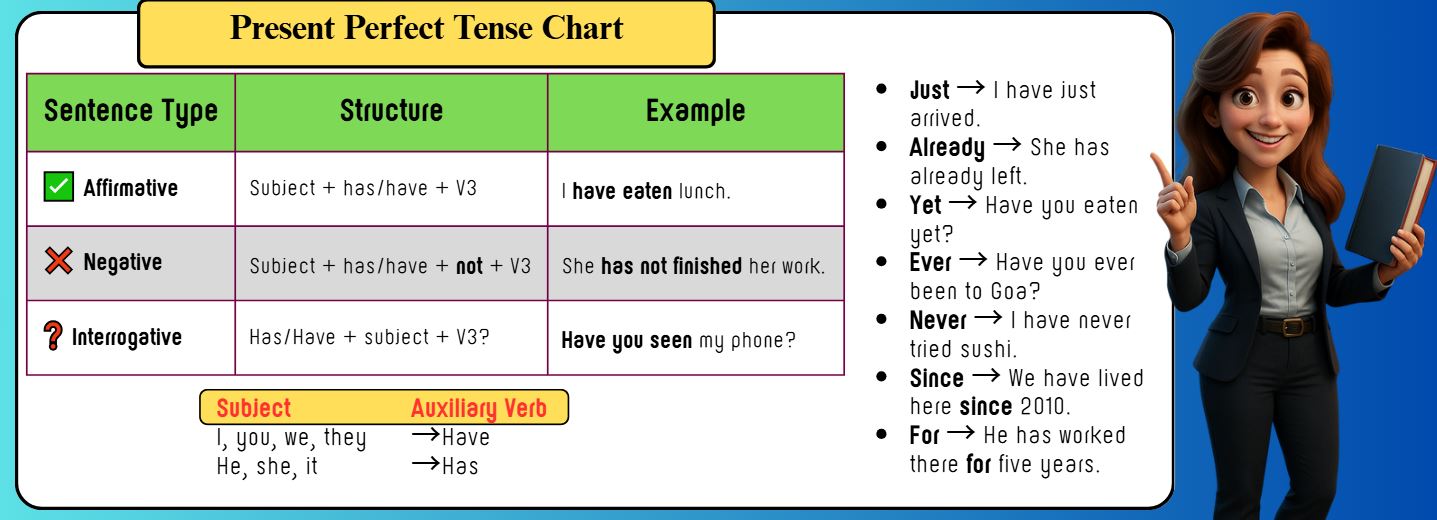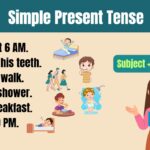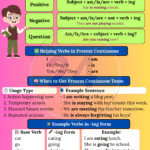Introduction
If you’ve ever said something like “I have finished my homework” or “She has gone to the market,” then you’ve already used the Present Perfect Tense—even if you didn’t know the name for it!
In this article, we’re going to explore the Present Perfect Tense in a simple and friendly way, perfect for beginners who want to improve their English grammar and speaking skills. Whether you’re a student, a job seeker, or just someone trying to speak better English, this tense is super useful in everyday conversations.
Let’s break it down step by step—with clear explanations, examples, and even a few recommended tools to help you learn faster.
What is the Present Perfect Tense?
The Present Perfect Tense is used when an action started in the past but is connected to the present. It tells us what has happened up to now.
📌 Structure:
Subject + has/have + past participle (V3)
- ✅ Use “has” with he, she, it, singular names
- ✅ Use “have” with I, you, we, they, plural names
Simple Examples:
Subject | Verb (V3) | Sentence |
I | eaten | I have eaten lunch. |
She | finished | She has finished her homework. |
They | gone | They have gone to the market. |
These actions are done, but they still matter right now.
💡 Real-Life Use:
- “I have lost my keys.” (I can’t find them now)
- “We have watched that movie already.” (The experience is complete)
- “He has never visited Delhi.” (Up to now, it hasn’t happened)
You can hear these kinds of sentences in real conversations, interviews, or even in English exams. So it’s important to understand and use this tense correctly.
Helpful Tools for Learning
If you find it difficult to remember the rules or practice speaking, a few smart tools can really help:
- 📘 Spoken English Books for Beginners – These books explain tenses and daily use sentences in a very simple way. Perfect for self-learners!
- 🎧 Noise-Cancelling Headphones – Block distractions and focus while listening to English practice audios.
- 💡 Study Lamp – A good study light can make your grammar sessions more comfortable, especially at night.
You can also read this:
How to Form the Present Perfect Tense
Forming the Present Perfect Tense is actually quite simple once you understand the pattern. It’s all about using “has” or “have” followed by the past participle (V3) of the verb.
Let’s break it down into three sentence types:
🔹 1. Affirmative (Positive) Sentences
Structure:
Subject + has/have + past participle (V3)
✅ Examples:
- I have finished my work.
- She has cooked dinner.
- They have reached the station.
🔹 2. Negative Sentences
Structure:
Subject + has/have + not + past participle (V3)
✅ Examples:
- I have not eaten anything.
- He has not come yet.
- We have not watched that movie.
🔹 3. Interrogative (Questions)
Structure:
Has/Have + subject + past participle (V3)?
✅ Examples:
- Have you seen my phone?
- Has she gone to school?
- Have they arrived?
You can easily practice these structures by making your own daily sentences. Think about what you’ve done today and try turning them into Present Perfect sentences.
📚 Learning Tip:
Writing grammar notes can really boost your understanding. If you study in bed or while sitting for long hours, a good laptop table can make learning more comfortable and help with better posture.
Examples of Present Perfect Tense
Let’s look at some real and easy examples to help you understand how the Present Perfect Tense works in everyday English.
We’ll divide them into three types for clarity:
🔹 Affirmative (Positive) Examples:
- I have completed my homework.
- She has cleaned the room.
- We have started our new project.
- They have booked the tickets.
- He has written five emails today.
These show that something has happened recently or is still relevant now.
🔹 Negative Examples:
- I have not finished my lunch.
- She has not arrived yet.
- They have not played the game.
- He has not replied to the message.
- We have not gone there before.
These sentences say that something hasn’t happened yet or ever.
🔹 Interrogative (Question) Examples:
- Have you eaten anything today?
- Has he called you?
- Have they traveled abroad?
- Have we met before?
- Has she finished her assignment?
These help you ask questions about actions or experiences up to now.
🎧 Make Practice More Fun and Focused
Listening to English audio and repeating sentences aloud is one of the best ways to master tenses like the Present Perfect. You can improve faster by using:
- Bluetooth Speakers – Play English audio while you’re doing chores or relaxing.
- Smart Speakers (Alexa) – Ask it to quiz you or practice English commands. It’s like having a mini teacher at home!
These tools help you learn hands-free and make grammar fun!
Common Verbs in Present Perfect Form
To use the Present Perfect Tense correctly, you need to know the past participle (V3) forms of verbs. Some are regular (just add -ed), but many are irregular and don’t follow a fixed rule.
Let’s look at a list of common verbs with their past participle forms:
📘 Verb Table (Base Form → Past Participle)
Base Verb | Past Participle (V3) | Example Sentence |
go | gone | She has gone to the market. |
eat | eaten | I have eaten breakfast. |
write | written | He has written a letter. |
read | read (same spelling) | We have read that book. |
do | done | They have done the work. |
take | taken | She has taken the keys. |
buy | bought | I have bought a new phone. |
see | seen | Have you seen this movie? |
speak | spoken | He has spoken to the manager. |
📝 Tip: Keep a small grammar notebook or use a book holder while studying. It helps you keep the book at eye level and improves focus.
- 📗 Book Holder for Study – Great for hands-free learning and long study hours.
Want a more complete list of irregular verbs? You’ll find that in most beginner grammar books.
When to Use Present Perfect Tense
Knowing when to use the Present Perfect Tense is just as important as knowing how to form it. This tense connects past actions with the present moment — it shows that something has happened recently or affects now.
Let’s break down the common situations where this tense is used:
🔹 1. Actions that just happened
Used with: just, already, yet
- I have just finished my homework.
- She has already left.
- Have you eaten yet?
These actions are completed, but they’re very recent or still relevant.
🔹 2. Life experiences
Used with: ever, never
- I have never been to London.
- Have you ever tried sushi?
- She has visited Goa twice.
These examples talk about things that happened at some point in life, but the exact time isn’t important.
🔹 3. Actions that started in the past and continue now
Used with: since, for
- We have lived here for five years.
- He has worked at that company since 2019.
- They have studied English for two months.
This shows ongoing situations that started earlier and are still true now.
🔹 4. Changes over time
- My English has improved a lot.
- The city has become more crowded.
- Prices have increased recently.
This use is common in conversations, news, and business English.
💡 Make Grammar Practice Easier
Long grammar study sessions can feel tiring. Make your space more comfortable with tools like:
- 🪑 Comfortable Study Chair – Great for back support while you sit and study for hours.
- 🗂️ Desk Organizer – Keeps your grammar books, pens, and notebooks neat and within reach.
Creating a clean and cozy study setup helps you stay focused—and actually enjoy grammar practice!
Present Perfect Tense vs Past Simple
Many English learners get confused between the Present Perfect Tense and the Past Simple Tense. Don’t worry—it’s very common, and we’ll clear it up right here.
The main difference lies in when the action happened and how it connects to the present.
📊 Comparison Table
Tense | Structure | Use When… | Example |
Present Perfect | has/have + past participle (V3) | Time is not specific / Result affects now | I have eaten lunch. (I’m not hungry now) |
Past Simple | verb + -ed / 2nd form | Action happened at a specific time in the past | I ate lunch at 1 PM. (Time is known) |
✅ More Examples:
Present Perfect:
- She has broken her phone. (Still broken now)
- We have met before. (At some unknown time in the past)
- He has lost his keys. (Still can’t find them)
Past Simple:
- She broke her phone last week.
- We met at the wedding in 2020.
- He lost his keys yesterday.
🎧 Grammar Tip for Better Listening Practice:
Understanding grammar through spoken English helps you pick up real usage faster. Try listening to grammar podcasts or English stories.
- 🎧 Headphones for Learning – Great for blocking out distractions while you listen and learn anywhere—at home, in the park, or even while traveling.
Common Mistakes in Present Perfect Tense
Even if you understand the rules, it’s easy to make small mistakes when using the Present Perfect Tense. Let’s look at the most common errors and how to fix them with simple examples.
❌ Mistake 1: Using the wrong auxiliary verb
Some learners mix up has and have.
🔸 Incorrect: She have finished her work.
✅ Correct: She has finished her work.
🔸 Tip:
- Use has with: he, she, it, or one person
- Use have with: I, you, we, they, or more than one person
❌ Mistake 2: Using the wrong verb form (Not using V3)
The Present Perfect Tense always uses the past participle (V3) form of the verb—not the simple past.
🔸 Incorrect: I have ate lunch.
✅ Correct: I have eaten lunch.
🔸 Tip: Make a list of common irregular verbs and practice them daily.
❌ Mistake 3: Adding a specific past time
The Present Perfect does not go with specific time words like yesterday, last week, or in 2010. Those are for Past Simple.
🔸 Incorrect: I have seen that movie yesterday.
✅ Correct: I saw that movie yesterday.
✅ Or (Present Perfect version): I have seen that movie already.
Make Revision Easier
Sometimes it’s the environment that holds you back from learning. Organizing your study desk and using the right tools makes revision smoother and more enjoyable.
- 🗂️ Desk Organizer – Keep your grammar notes, flashcards, and pens in one place.
- 💡 Study Lamp – A focused light helps avoid eye strain during long study hours.
Fixing small mistakes can take your English from “okay” to “confident” in no time!
Practice Exercises
Now that you’ve learned the rules and seen examples, it’s time to practice. Don’t just read—try using the Present Perfect Tense yourself. Practice is the key to remembering grammar and using it in real conversations.
Here are some simple exercises you can try:
✍️ Exercise 1: Fill in the blanks
Complete the sentences using the correct form of the verb in Present Perfect Tense:
- I __________ (finish) my homework.
- She __________ (not arrive) yet.
- They __________ (visit) the museum.
- Have you __________ (see) this movie?
- We __________ (live) here since 2020.
👉 Answers:
- have finished
- has not arrived
- have visited
- seen
- have lived
✍️ Exercise 2: Make sentences
Write your own sentences using these prompts:
- Just (e.g., I have just…)
- Already
- Never
- Since
- Yet
👉 Example:
“I have already eaten lunch.”
💬 Exercise 3: Speak aloud
Stand in front of a mirror or use your phone to record yourself saying:
- 3 affirmative sentences
- 2 negative sentences
- 2 questions
This helps improve fluency and confidence.
🎯 Learning Tip
Keep your grammar book open and sit comfortably while practicing. Use helpful tools to create a better learning zone:
- 📘 Spoken English Book for Beginners – Comes with grammar rules, sentence examples, and practice questions.
- 🪑 Comfortable Study Chair – Helps you stay focused without back pain during long sessions.
Even 10 minutes of daily practice can make a big difference!
Recommended Study Tools & Resources
Learning grammar—especially something like the Present Perfect Tense—becomes easier and more enjoyable when you use the right tools. Whether you’re a student, a job seeker, or someone trying to speak fluent English, these resources can help you learn faster and stay motivated.
📚 1. Books for Practice and Understanding
Reading books designed for beginners helps you understand grammar step by step.
- ✅ English Conversation Practice Book
A great book for mastering real-life sentence patterns using tenses, including the Present Perfect. - ✅ Spoken English Book for Beginners
Simple explanations, common phrases, and plenty of examples make it perfect for self-learners.
💡 2. Study Tools That Keep You Focused
Having a clean and comfortable study area really helps with concentration, especially during grammar sessions.
- 💺 Comfortable Study Chair
If you’re sitting for long hours, back support is essential. This chair makes learning stress-free. - 📥 Desk Organizer
Keep your pens, grammar notes, flashcards, and other materials neatly arranged.
🎧 3. Listening Tools for English Practice
Hearing correct usage of the Present Perfect Tense improves your speaking skills naturally.
- 🎧 Bluetooth Speaker
Listen to English audiobooks or grammar lessons while doing other tasks—great for multitasking learners. - 🗣️ Smart Speaker (Alexa)
Practice your English by talking to Alexa. You can ask questions, play English games, or even learn new words.
📝 Pro Tip:
Create a daily 15-minute routine. Read a grammar rule, write 2–3 sentences, and speak them aloud. Use the tools above to make it smooth and fun.
FAQs – Present Perfect Tense
Here are some of the most frequently asked questions by English learners about the Present Perfect Tense. These quick answers will help clear up any confusion.
❓ What is the Present Perfect Tense in simple words?
It’s a tense used to talk about something that happened in the past but is still connected to the present.
🟢 Example: I have finished my work. (It’s done now)
❓ When should I use Present Perfect instead of Past Simple?
Use Present Perfect when:
- The exact time isn’t mentioned
- The result is still important now
- The action has happened recently or many times in life
Use Past Simple when:
- The action is finished and the time is clear
- Example: I ate breakfast at 8 AM.
❓ Can I use specific time words like “yesterday” with Present Perfect?
No. Words like yesterday, last year, in 2010 go with Past Simple, not Present Perfect.
🛑 Incorrect: I have gone to the park yesterday.
✅ Correct: I went to the park yesterday.
❓ What’s the difference between “has” and “have” in this tense?
- Use has with: he, she, it, singular names
- Use have with: I, you, we, they, plural names
❓ What are the signal words for Present Perfect Tense?
Some common words and phrases:
- Just, already, yet, never, ever, recently, so far, since, for
These help you identify that the sentence is using the Present Perfect Tense.
Final Thoughts on Present Perfect Tense
The Present Perfect Tense may seem tricky at first, but once you understand the structure and when to use it, it becomes much easier. It’s one of the most useful tenses in English, especially when you’re talking about recent actions, life experiences, or things that still matter now.
Let’s quickly recap what you’ve learned:
✅ The structure is has/have + past participle (V3)
✅ Use it when the action connects the past to the present
✅ Avoid specific past times like “yesterday”
✅ Practice with examples to build confidence
✅ Use helpful tools like grammar books, headphones, or a clean study space
📌 Final Tips for Learners:
- Practice daily using short sentences from your life.
- Record yourself speaking to improve fluency.
- Use the right tools to make learning smoother and more fun:
📘 Try this Spoken English Book for Beginners to strengthen your basics.
🎧 Use Noise-Cancelling Headphones to focus during listening and speaking practice.
📢 Amazon Affiliate Disclosure
As an Amazon Associate, I earn from qualifying purchases. This means that if you click on a product link and make a purchase, I may receive a small commission at no extra cost to you. I only recommend products I truly believe will help my readers learn better and faster.


